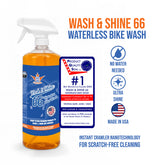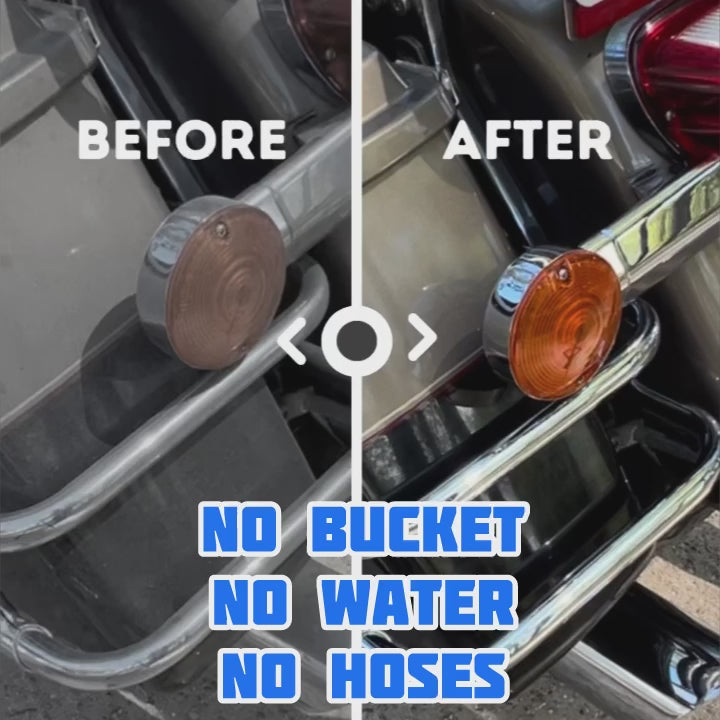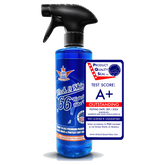How to Prevent Rust on Cars: Easy Steps for Owners
Keeping your car free from rust is more than just a matter of looks. Rust can silently destroy critical parts of your vehicle, and regular cleaning can reduce rust risk by removing up to 90 percent of harmful salt and grime. Most drivers focus on polishing paint and shining wheels, but that hardly scratches the surface. The real secret to preventing rust starts with the way you clean, inspect, and protect your car long before any orange spots show up.
Table of Contents
- Step 1: Clean Your Car Thoroughly
- Step 2: Inspect For Existing Rust
- Step 3: Apply Rust Inhibitor Products
- Step 4: Maintain A Regular Washing Schedule
- Step 5: Store Your Car Properly
Quick Summary
| Key Point | Explanation |
|---|---|
| 1. Thoroughly clean your car regularly | Cleaning removes contaminants that can trap moisture, preventing rust formation on metal surfaces. |
| 2. Inspect for existing rust diligently | Conducting regular visual and tactile inspections helps catch and address rust before it escalates into severe damage. |
| 3. Apply rust inhibitor carefully | A rust inhibitor creates a barrier against moisture, halting oxidation when applied properly to clean and dry surfaces. |
| 4. Maintain a consistent washing schedule | Regular washing, especially in harsh conditions, minimizes corrosive buildup and extends your vehicle’s lifespan. |
| 5. Store vehicle properly to prevent rust | Indoor storage with controlled humidity or strategically planned outdoor parking protects against moisture-related corrosion. |
Step 1: Clean Your Car Thoroughly
Preventing rust begins with a thorough and meticulous car cleaning process. The first line of defense against automotive corrosion is removing dirt, road salt, debris, and other contaminants that can trap moisture against your vehicle’s metal surfaces. A comprehensive cleaning not only improves your car’s appearance but creates a critical protective foundation for rust prevention.
Start by selecting the right cleaning tools and materials for a complete exterior wash. You’ll want microfiber towels, a high-quality car wash soap specifically designed for automotive surfaces, multiple clean wash mitts, and access to clean water. Begin with a pre-rinse to remove loose surface debris, paying special attention to wheel wells, undercarriage areas, and areas prone to salt and grime accumulation. These regions are rust’s favorite starting points and require extra care during cleaning.
Working systematically from top to bottom, wash your vehicle using gentle circular motions. Use separate wash mitts for different areas to prevent cross-contamination dirt transfer. Your roof, hood, and upper body panels should be cleaned first, followed by sides, then lower sections and bumpers. When cleaning lower sections, take extra time to remove mud, road salt, and accumulated grime that can accelerate metal corrosion. Learn more about our waterless car washing techniques that can help protect your vehicle’s finish while minimizing water usage.
After washing, thoroughly dry your vehicle using clean microfiber towels. Moisture is rust’s primary catalyst, so removing all water droplets is crucial. Pay particular attention to crevices, panel gaps, and areas around door handles where water can accumulate. A comprehensive drying process helps prevent water from sitting on metal surfaces and initiating the oxidation process that leads to rust formation.
Finally, inspect your vehicle’s paint and body for any existing scratches, chips, or areas where protective coating might have worn away.
The following table organizes the essential tools and materials needed for a thorough car cleaning to prevent rust, summarizing each item and its specific purpose.
| Tool/Material | Specification/Type | Purpose |
|---|---|---|
| Microfiber Towels | Lint-free, absorbent | For gently drying the car and preventing scratches |
| Car Wash Soap | Automotive-specific, pH-neutral | Removes contaminants without stripping protective coatings |
| Wash Mitts | Soft, separate for upper and lower panels | For safe, effective cleaning and avoiding cross-contamination |
| Clean Water | Fresh, free of debris | Essential for rinsing away dirt and soap |
| High-Pressure Rinse | Hose or pressure washer | Removes loose debris, salt, and grime |
| Bright Flashlight | LED or strong beam | Assists with inspection of hard-to-see areas |
| Magnet with Cloth | Small magnet wrapped in cloth | Checks for body filler or hidden rust spots |
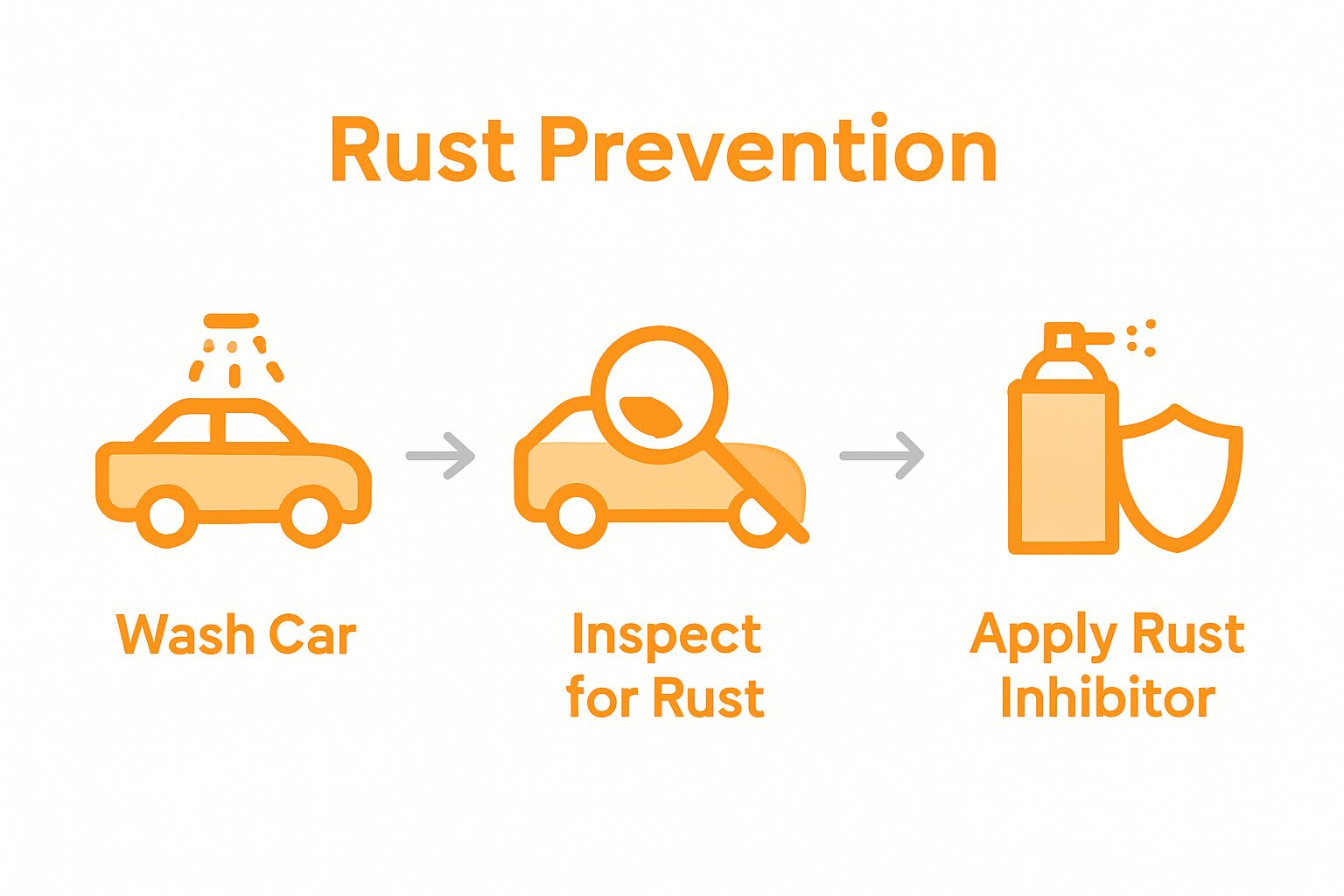
Step 2: Inspect for Existing Rust
After thoroughly cleaning your car, the next critical step in preventing extensive rust damage is conducting a comprehensive visual and tactile inspection. Rust can begin silently and spread quickly, making early detection crucial for maintaining your vehicle’s structural integrity and appearance.
This step requires patience, good lighting, and a systematic approach to identifying potential problem areas before they escalate.
Begin your inspection in well-lit conditions, preferably natural daylight or a bright garage setting. Start with the most vulnerable areas of your vehicle where rust commonly develops. These include wheel wells, rocker panels, the undercarriage, door edges, and around windshield and window frames. Look for telltale signs of rust formation: small bubbles or discoloration in the paint, reddish-brown spots, or areas where paint seems to be lifting or separating from the metal surface. These are early warning indicators that oxidation has begun.
Run your hand gently along surfaces, feeling for any irregularities that might indicate rust developing beneath the paint. Small bumps, rough patches, or areas where the paint feels different can signal underlying metal corrosion. Use a bright flashlight to illuminate hard-to-see areas, helping you detect subtle changes in the metal’s surface. Check out our guide on motorcycle maintenance which includes similar inspection techniques applicable to rust prevention across different vehicles.
For a more detailed examination, you might want to use a small magnet wrapped in a soft cloth. Drag the magnet across suspect areas. If the magnet’s smooth movement is interrupted or it seems to catch on certain spots, this could indicate body filler used to cover previous rust damage. Professionally repaired rust spots often have uneven surfaces that differ from the original metal’s smooth texture.
Pay special attention to your vehicle’s undercarriage, which is most exposed to moisture, road salt, and debris. Use a creeper or jack stands to safely inspect underneath your car, looking for rust formation on frame rails, suspension components, and other metal structures. Rust in these areas can compromise your vehicle’s structural safety, so thorough inspection is crucial. If you discover significant rust development, consider consulting a professional auto body technician who can assess the extent of corrosion and recommend appropriate repair strategies before the damage becomes irreversible.
Step 3: Apply Rust Inhibitor Products
Applying rust inhibitor products is your vehicle’s most critical defensive strategy against corrosion. These specialized treatments create a protective barrier that prevents moisture and oxygen from interacting with metal surfaces, effectively halting the oxidation process before it can cause significant damage. The application requires careful preparation and precise technique to ensure maximum protection.
Before applying any rust inhibitor, ensure your vehicle’s surface is completely clean and completely dry from the previous washing and inspection stages. Temperature and humidity play significant roles in product effectiveness, so choose a dry day with temperatures between 50-80 degrees Fahrenheit for best results. Work in a well-ventilated area with indirect sunlight to prevent rapid product evaporation or uneven application.
Select a high-quality rust inhibitor appropriate for your vehicle’s specific needs. Some products work best on bare metal, while others are designed to be applied over existing paint. Learn more about our specialized coating techniques that can provide long-lasting protection. When applying, use clean microfiber applicators or spray equipment recommended by the manufacturer. Start with small, inconspicuous areas to test product compatibility and understand the application technique.
Apply the rust inhibitor in thin, even layers, allowing each coat to dry completely before adding subsequent layers. Pay extra attention to areas previously identified during your inspection as vulnerable to rust: wheel wells, undercarriage, door edges, and panel seams. These regions require more thorough coverage. Use a systematic approach, working methodically from top to bottom, ensuring complete and consistent coverage without pooling or uneven application.
After application, allow the rust inhibitor sufficient time to cure according to manufacturer instructions. This typically ranges from 24 to 48 hours, during which the product forms a hard, protective molecular barrier against moisture and environmental contaminants. Avoid washing or exposing the vehicle to water during this curing period to ensure maximum product effectiveness.
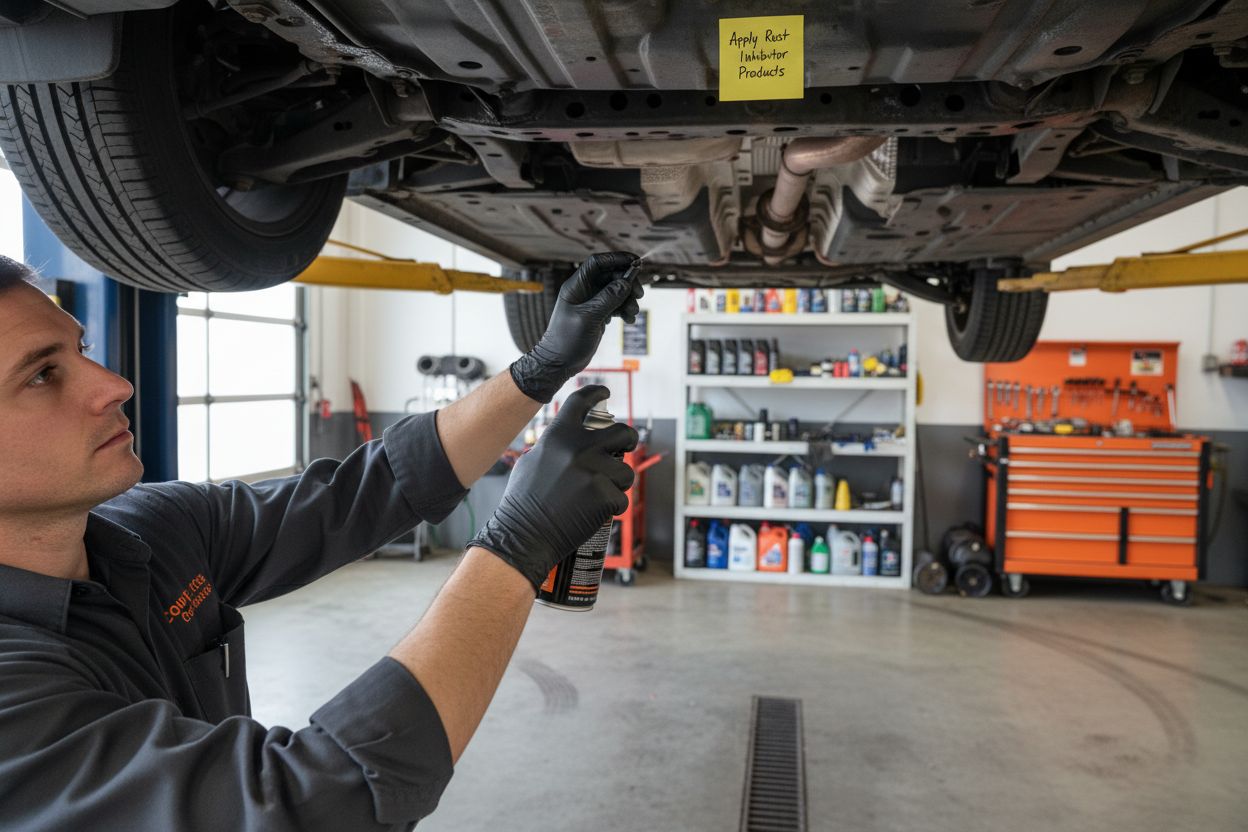 Regular maintenance and reapplication every 12-18 months will help maintain continuous protection against rust formation, preserving your vehicle’s appearance and structural integrity for years to come.
Regular maintenance and reapplication every 12-18 months will help maintain continuous protection against rust formation, preserving your vehicle’s appearance and structural integrity for years to come.
Step 4: Maintain a Regular Washing Schedule
Consistent vehicle washing is your first line of defense against rust formation, transforming routine maintenance into a proactive protection strategy. Regular cleaning removes corrosive contaminants that can accelerate metal deterioration, making it an essential practice for preserving your car’s long-term structural integrity. Learn more about deep cleaning techniques to enhance your maintenance approach.
Establish a washing frequency that matches your vehicle’s exposure to environmental challenges. Cars in coastal regions with high salt air, areas with frequent winter road treatments, or locations with significant industrial pollution require more frequent washing compared to vehicles in milder environments. Aim to wash your car at least every two weeks, with more frequent cleaning during seasons with aggressive environmental conditions like winter or extended periods of high humidity.
Develop a systematic washing routine that goes beyond superficial appearance. Each washing session should involve thorough rinsing of undercarriage areas, wheel wells, and other regions prone to dirt and salt accumulation. Use pH-neutral car wash solutions that effectively remove contaminants without stripping protective coatings. Start with a comprehensive rinse to remove loose debris, then apply soap using microfiber mitts in gentle, circular motions. Pay special attention to areas where rust commonly develops: around trim pieces, behind bumpers, and along lower body panels.
Beyond visual cleanliness, each washing session presents an opportunity for detailed inspection. As you clean, look for emerging signs of paint damage, chips, or areas where protective coatings might be wearing thin. These moments allow you to address potential rust initiators before they become significant problems.
This table provides a summary of common car areas prone to rust, including what to look and feel for during inspections and why each area is vulnerable.
| Area Inspected | What to Look/Feel For | Reason for Vulnerability |
|---|---|---|
| Wheel Wells | Bubbles, discoloration, rough patches | Trap moisture, exposed to road salt/grime |
| Rocker Panels | Rust spots, lifts in paint | Collect debris, often ignored when washing |
| Undercarriage | Surface rust, brown spots or flakes | Direct exposure to moisture and salt |
| Door Edges | Paint lifting, roughness | Crevices collect water and dirt |
| Window/Windshield Frames | Small blisters, uneven texture | Water seeps and accumulates in seams |
| Suspension Components | Flaking, intermittent surface rust | Close contact with road hazards |
Consider supplementing your manual washing routine with additional protective strategies. Applying a high-quality automotive wax after washing creates an additional barrier against moisture and environmental contaminants. During winter months or in regions with aggressive road treatments, consider more frequent washing and immediate drying to prevent salt and chemical residues from initiating the corrosion process. Remember that prevention is always more cost-effective than extensive rust repair, making your regular washing schedule an investment in your vehicle’s longevity and aesthetic appeal.
Step 5: Store Your Car Properly
Proper vehicle storage is a critical yet often overlooked strategy in preventing rust formation, offering protection against environmental factors that accelerate metal corrosion. The environment where you park and store your car can significantly impact its long-term structural integrity and appearance. Learn more about surface protection techniques that can help maintain your vehicle’s condition.
Indoor storage represents the gold standard for rust prevention. If possible, park your vehicle in a garage with consistent temperature and controlled humidity levels. Avoid storing your car in areas with high moisture content or extreme temperature fluctuations, which can create condensation that accelerates rust development. If a heated garage is unavailable, invest in a high-quality, breathable car cover that allows moisture to escape while protecting against dust and environmental contaminants.
When outdoor storage is unavoidable, choose your parking location strategically. Avoid areas with direct ground contact that can trap moisture, such as grassy surfaces or areas prone to puddles. Opt for concrete or asphalt surfaces that provide better drainage and reduce moisture accumulation underneath your vehicle. Consider using a specially designed car port or carport with a waterproof roof to minimize direct exposure to rain, snow, and other corrosive environmental elements.
Prepare your vehicle for long-term storage by implementing several protective measures. Apply a comprehensive rust inhibitor before extended periods of non-use, ensuring all metal surfaces receive thorough coverage. Clean the vehicle completely, removing any dirt or salt residues that could trap moisture. If storing for extended periods, consider using moisture-absorbing desiccant bags inside the vehicle and underneath to prevent humidity buildup. Inflate tires to recommended pressure and use jack stands to prevent tire flat spots and reduce pressure on suspension components.
Maintain your stored vehicle periodically to prevent rust formation during inactive periods. Start the engine and drive the vehicle briefly every few weeks to circulate fluids and prevent seals from drying out. During these maintenance drives, inspect for any emerging signs of rust or moisture accumulation. Apply additional rust inhibitor as needed, and ensure all protective coatings remain intact. By treating storage as an active preservation strategy rather than a passive holding period, you can significantly extend your vehicle’s lifespan and maintain its structural and aesthetic quality for years to come.
Protect Your Car From Rust With Proven Professional Solutions
You have learned how even a small oversight in washing or inspection can open the door for rust to silently attack your vehicle. The frustration of seeing hidden rust spots appear after a rainy season or a harsh winter is avoidable. Keeping your car clean, dry, and shielded with long-lasting coatings is the real key to stopping rust before it starts.
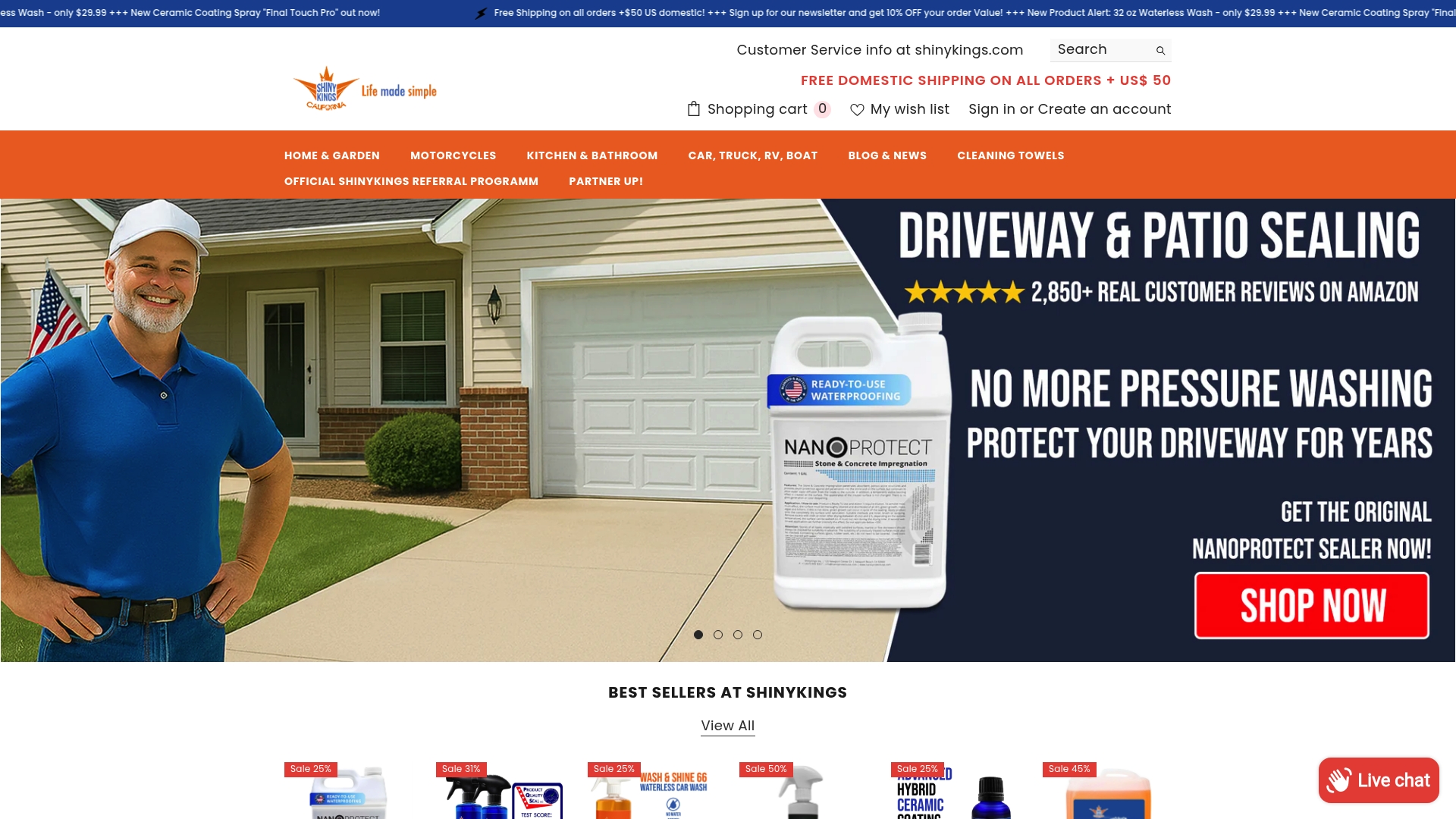
Ready to shield your vehicle with the same advanced products trusted by professionals? Explore the science behind our world-unique car sealants, graphene coatings, and tailored cleaning formulas to reinforce the simple steps you just learned. Visit Shiny Kings for exclusive access to our specialized carwash products and coatings that lock out moisture and block oxidation. Take action now and give your car the protection it deserves—your next drive deserves that peace of mind.
Frequently Asked Questions
How can I prevent rust on my car?
To prevent rust on your car, start with a thorough cleaning to remove dirt and salt, then apply a rust inhibitor to create a protective barrier. Make it a habit to wash your vehicle at least every two weeks to keep contaminants at bay and inspect for signs of rust during each wash.
What are the best areas to inspect for rust?
The best areas to inspect for rust include wheel wells, rockers panels, the undercarriage, and around door edges. Regularly visually and palpably check these vulnerable spots for small bubbles, discoloration, or rough patches that may indicate the onset of rust.
How often should I wash my car to prevent rust?
Aim to wash your car at least every two weeks, especially during winter or in areas with high salt levels. This regular washing helps remove corrosive materials and prevents them from accumulating and initiating rust formation.
What steps should I take if I find existing rust on my car?
If you find existing rust, promptly address it by sanding down affected areas and applying a rust inhibitor. Consider consulting a professional for more severe rust damage to ensure it is properly repaired and safeguarded.
How do I apply a rust inhibitor effectively?
To apply a rust inhibitor effectively, make sure your car is clean and dry, then use thin, even layers of the product over all metal surfaces. Focus particularly on areas prone to rust, allowing each coat to cure fully before applying additional layers.
What should I do when storing my car to prevent rust?
When storing your car, ensure it’s clean and apply a rust inhibitor before placing it in a controlled environment, ideally indoors. Use breathable covers to protect from dust and moisture, and occasionally run the vehicle or inspect it to prevent rust from developing during inactivity.


